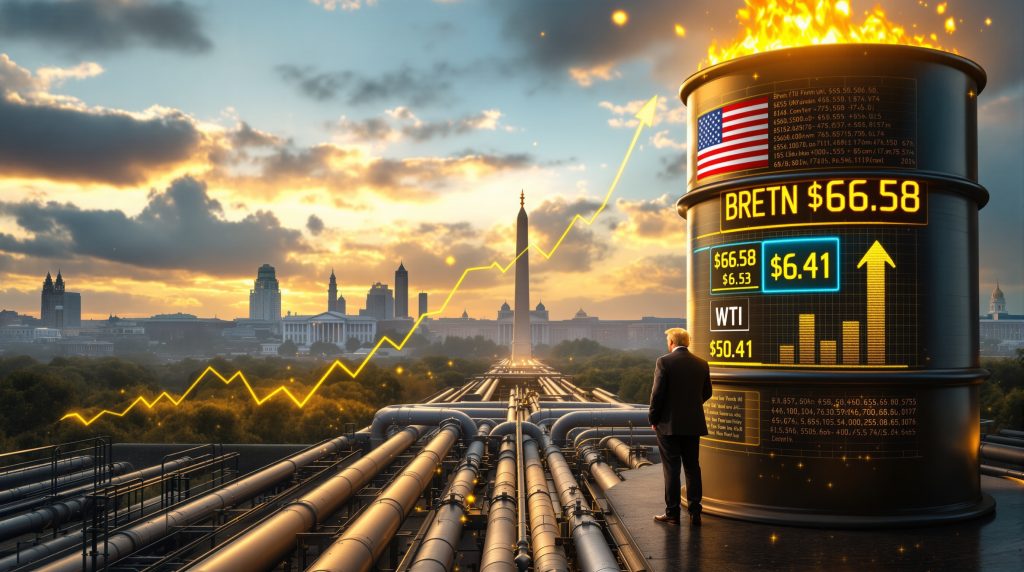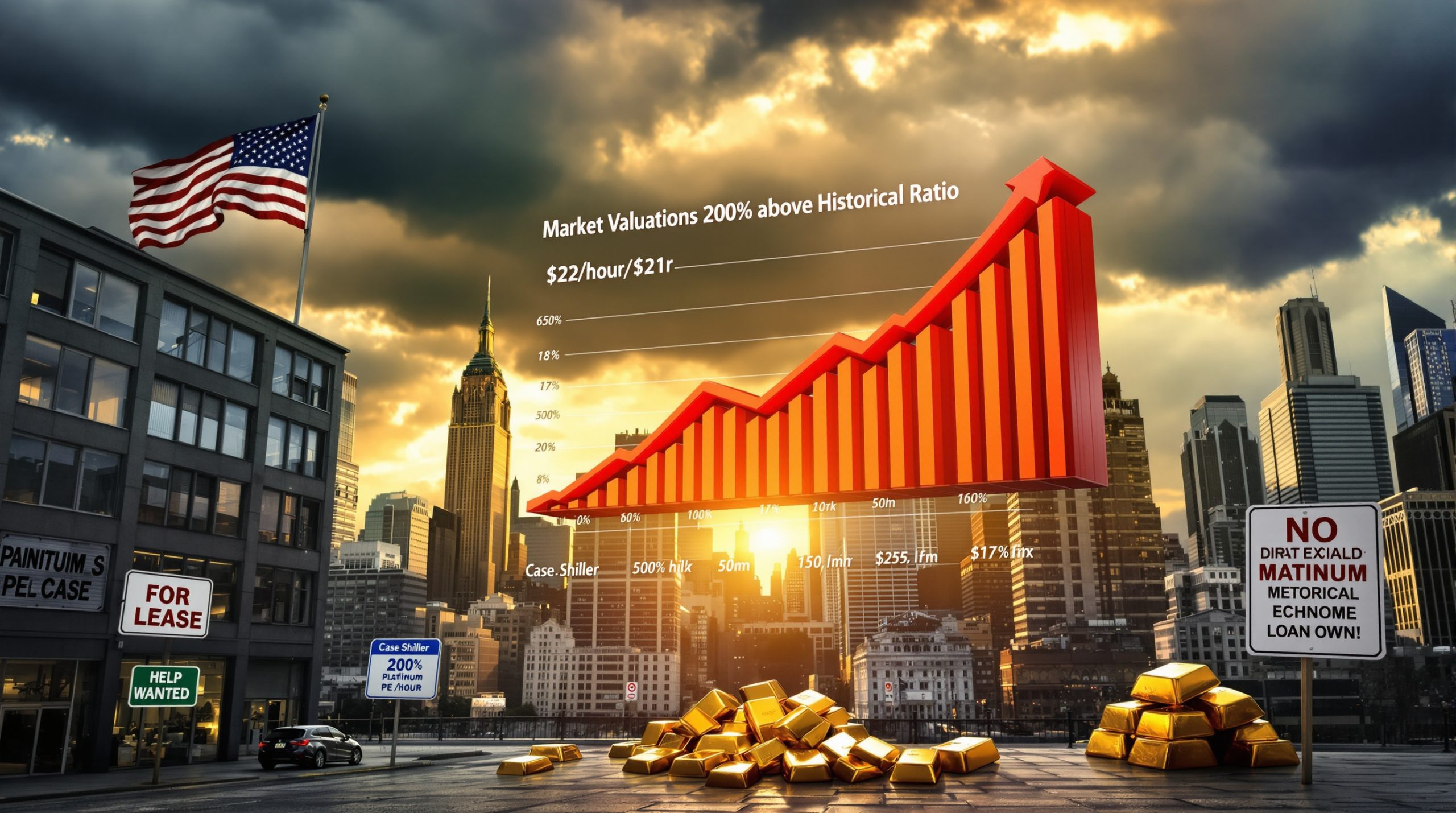Why Are Oil Prices Rising Amid Diplomatic Meetings?
Oil prices showed positive movement today with Brent crude rising 1.11% to $66.58 per barrel and WTI crude gaining 0.97% to reach $63.41. This upward trend coincides with Ukrainian President Volodymyr Zelensky's arrival in Washington for diplomatic discussions with former President Donald Trump, signaling potential shifts in geopolitical dynamics that could impact global energy markets.
The timing of this diplomatic engagement has caught the attention of energy traders worldwide, as discussions between Zelensky and Trump could significantly influence future policies related to Eastern European energy security and global oil supply chains.
Market analysts suggest that the modest price increases reflect a cautious optimism among traders who are carefully weighing geopolitical developments against broader supply-demand fundamentals.
What's Driving Current Oil Market Movements?
Geopolitical Tensions and Diplomatic Developments
The timing of Zelensky's Washington visit comes amid ongoing concerns about energy security and supply routes. Recent reports indicate Ukrainian forces targeted a Russian pipeline hub, potentially disrupting oil flows through the Druzhba pipeline. Hungary has reported that Russian oil flows were temporarily halted following this attack, highlighting the vulnerability of energy infrastructure in conflict zones.
This development represents a significant escalation in energy infrastructure targeting, which traditionally has been considered off-limits even during military conflicts. The potential for expanded disruptions to major European oil supply routes has introduced additional volatility into market calculations.
Supply Disruptions and Infrastructure Concerns
Several recent developments have contributed to market nervousness:
- Hungarian authorities confirmed disruption to Russian oil flows through the Druzhba pipeline
- One of Russia's largest refineries reportedly halted crude intake
- Ukraine's strategic targeting of Russian energy infrastructure ahead of diplomatic summits
- Increased military activity near key Black Sea shipping lanes
These infrastructure vulnerabilities come at a particularly sensitive time for global oil markets, as they coincide with scheduled production increases from OPEC+ members.
OPEC+ Production Decisions and Market Balance
The oil market is currently processing the implications of OPEC+ accelerating the rollback of production cuts. The group is on track to reverse 2.2 million barrels per day in cuts by September's end, potentially creating supply pressures that could counterbalance price gains from geopolitical tensions.
This production increase strategy has raised questions about OPEC's long-term market share objectives. According to Scott Sheffield, former CEO of Pioneer Natural Resources, "The best way [for OPEC] to gain market share is to keep oil prices in the $60s range for several years. This will reduce investment in US shale, Canada, Brazil and oil exploration around the world… [it] will force consolidation."
The International Energy Agency (IEA) has forecasted demand growth of 680,000 barrels per day for 2025, rising to 700,000 barrels per day in 2026. However, this growth rate may not be sufficient to absorb both returning OPEC+ volumes and projected non-OPEC production increases.
How Are Regional Oil Markets Performing?
North American Oil Benchmarks
Beyond WTI's rise to $63.41, other North American benchmarks show varied performance:
- Louisiana Light trading at $66.14 (down 1.21% over 7 days)
- Western Canadian Select at $49.63 (unchanged in last 15 hours)
- Eagle Ford at $60.44 (up 2.22% over 5 days)
- Canadian Condensate at $64.13 (unchanged over 15 hours)
- Premium Synthetic at $62.38 (unchanged over 15 hours)
- Peace Sour at $53.98 (unchanged over 15 hours)
This varied performance across North American benchmarks reflects regional supply-demand dynamics, transportation constraints, and quality differentials that affect pricing across different production basins. Furthermore, the ongoing US drilling slowdown is beginning to influence regional benchmark performance.
Middle Eastern and African Benchmarks
Middle Eastern grades are showing strength with:
- Murban crude at $69.02 (up 1.08%)
- Iran Heavy at $64.96 (down 1.16% over 50 days)
- Basra Light at $71.69 (down 4.78% over longer term)
The premium commanded by Middle Eastern grades over WTI reflects both quality advantages and proximity to major Asian markets, particularly China and India, which continue to drive global demand growth despite economic headwinds.
What's Happening With Other Energy Commodities?
Natural Gas and Refined Products
While oil benchmarks are rising, natural gas is moving in the opposite direction:
- Natural gas down 0.41% to $2.904
- Gasoline futures up 1.29% to $2.099
- Heating oil showing similar upward movement
This divergence between oil and natural gas prices highlights the different market fundamentals affecting these energy commodities. Natural gas markets remain well-supplied in North America, while refined products like gasoline are more directly influenced by crude oil price movements and seasonal demand patterns.
The disconnect between natural gas and oil prices also reflects structural changes in global energy markets, including the growing influence of LNG trade and regional pricing differentials.
How Might Trump-Zelensky Talks Impact Energy Markets?
Potential Policy Implications
The meeting between Trump and Zelensky could signal shifts in U.S. policy toward the Russia-Ukraine conflict, with potential implications for:
- Sanctions policies affecting Russian energy exports
- U.S. support for European energy security initiatives
- Long-term diplomatic approaches to resolving conflicts affecting energy corridors
- Strategic oil reserve management policies
Any significant policy shifts would likely introduce additional volatility into energy markets already struggling to price in complex geopolitical risks alongside evolving supply-demand fundamentals. The recent Alaska policy shift has already demonstrated how quickly energy policies can change under different administrations.
Market Sentiment and Investor Reactions
Traders appear to be factoring in the possibility of new diplomatic developments, with the modest price increases suggesting cautious optimism rather than dramatic shifts in market fundamentals.
The cautious market reaction reflects broader uncertainty about global economic growth, which continues to weigh on oil demand forecasts despite relatively tight physical markets for certain crude grades and refined products.
What Other Global Factors Are Influencing Oil Markets?
Chinese Demand Signals
Recent data shows China's oil demand picked up in July, with the country maintaining strong refining output despite economic headwinds. However, Chinese refiners are reportedly facing deepening losses due to overcapacity issues, which could affect future demand patterns.
China's demand outlook remains a critical variable for global oil markets, as the country's consumption growth has historically driven major price cycles. Recent economic stimulus measures have produced mixed results, creating uncertainty about the sustainability of Chinese oil demand growth in coming quarters.
U.S. Production Outlook
U.S. production dynamics remain complex:
- The U.S. Geological Survey has mapped fresh oil and gas potential in the Rockies
- Industry analysts suggest U.S. shale may be approaching efficiency limits
- Lower oil prices are creating headwinds for production growth
Kirk Edwards, CEO of Latigo Petroleum, highlighted these challenges in a recent Financial Times interview: "We are not going to be putting any more rigs out until prices get back and stabilise in the $75 range ahead. You will see US production start to drop in the fall and into 2026."
The EIA's Short-Term Energy Outlook indicates that persistent low oil prices in early 2026 will likely lead to supply reductions by both OPEC+ and non-OPEC producers, potentially setting the stage for the next price cycle.
How Are Geopolitical Tensions Affecting Oil Infrastructure?
Pipeline Disruptions and Security Concerns
The reported Ukrainian attack on the Druzhba pipeline highlights ongoing vulnerabilities in energy transit routes. This follows a pattern of infrastructure targeting that increases market volatility and supply uncertainty.
Energy infrastructure security has emerged as a critical concern as conflicts increasingly target economic assets. The Druzhba pipeline, which delivers approximately 750,000 barrels per day of Russian crude to Central European refineries, represents a particularly vulnerable chokepoint in European energy security.
Analysts note that disruptions to such critical infrastructure can have cascading effects throughout regional energy systems, potentially affecting refinery operations, product availability, and consumer prices across multiple countries.
Regional Export Developments
Several notable developments are affecting regional export patterns:
- Venezuelan crude reportedly heading to the U.S. after policy adjustments
- China's fuel exports jumping to a 13-month high
- India exploring new crude sourcing options as prices fluctuate
These shifting trade flows reflect both geopolitical realignments and economic opportunism as market participants navigate sanctions regimes, freight differentials, and evolving refinery demand patterns. The potential trade war oil impact continues to influence global trading patterns and price differentials.
What Do Recent Market Movements Mean For Energy Prices?
Price Stability Factors
Despite today's gains, several factors suggest potential price pressures:
- IEA projections of weaker-than-anticipated demand growth
- Accelerated OPEC+ production increases
- Concerns about global economic growth affecting consumption
- An all-time high glut in global inventories potentially exceeding 2020 pandemic levels
These fundamental factors create a challenging environment for sustained price increases despite the bullish influence of geopolitical tensions and infrastructure security concerns. Additionally, Trump tariffs impact oil markets in ways that add complexity to price forecasting.
Investment and Production Trends
Industry investment patterns show mixed signals:
- Saudi Arabia reportedly scaling back some megaproject values amid oil price concerns
- Brazil extending exploration deadlines as Petrobras confirms new oil finds
- Algeria moving toward shale gas deals with major international companies
A chief economist at Abu Dhabi Commercial Bank noted that "A sharper and sustained fall in the oil price would require a deeper retrenchment in government spending to contain the size of the shortfall and the building in government debt," highlighting the fiscal challenges facing major oil-producing nations.
The current price environment has accelerated industry consolidation while discouraging high-cost exploration projects, potentially setting the stage for future supply constraints once demand growth resumes.
Frequently Asked Questions About Current Oil Markets
Why are oil prices rising despite concerns about oversupply?
The current price increases reflect immediate geopolitical concerns outweighing longer-term supply-demand fundamentals. Markets are reacting to potential disruptions from conflict zones while still processing the implications of OPEC+ production increases.
This tension between short-term supply security concerns and longer-term oversupply risks creates a volatile trading environment where price movements may appear disconnected from headline inventory figures or production statistics.
How might Trump-Zelensky talks affect global energy markets?
Any signals about future U.S. policy toward the Russia-Ukraine conflict could impact sanctions regimes, energy security initiatives, and diplomatic approaches to resolving conflicts affecting major energy transit routes.
Market participants are particularly focused on whether such diplomatic engagements might lead to de-escalation in regions affecting energy infrastructure or conversely signal potential for expanded conflicts that could further threaten supply security. The ongoing US tariff pressures complicate these diplomatic calculations.
What's the outlook for oil prices in the coming months?
Market analysts suggest volatility will continue as traders balance geopolitical tensions against supply increases and uncertain demand growth. The resolution of current diplomatic initiatives and production decisions by major exporters will be key factors to watch.
Technical indicators suggest oil prices are trading in a well-defined range, with resistance levels near $70 for Brent crude and support around $60. Breaking out of this range would likely require significant shifts in either physical market fundamentals or geopolitical risk assessments.
Disclaimer: Oil price forecasts involve substantial uncertainty. The analysis presented represents current market assessments based on available information, but actual outcomes may differ significantly due to unpredictable geopolitical events, policy changes, economic developments, or other factors outside market participants' control.
How are U.S. shale producers responding to current price levels?
U.S. shale producers are demonstrating increased capital discipline, with many companies prioritizing shareholder returns over production growth. According to industry executives, current prices below $75 per barrel are insufficient to drive significant rig additions or production increases.
This disciplined approach represents a significant shift from previous price cycles, when U.S. producers rapidly increased output in response to price increases, often undermining market recovery through oversupply.
Market Outlook and Investment Considerations
The current oil market presents a complex picture for investors and industry participants. While short-term price movements reflect immediate concerns about supply security and infrastructure vulnerabilities, longer-term fundamentals suggest a market moving toward oversupply as OPEC+ production increases outpace global demand growth.
For energy market participants, this environment requires careful risk management and scenario planning to navigate potential price volatility and supply disruptions. The outcome of diplomatic initiatives, including the Zelensky-Trump talks, could significantly influence market sentiment and policy directions affecting global energy flows.
As geopolitical tensions continue to affect energy infrastructure security, market participants should maintain heightened awareness of potential disruption risks while also monitoring the structural evolution of supply-demand fundamentals that will shape longer-term price trajectories.
Want to Spot the Next Major Mineral Discovery Before the Market?
Stay ahead of the market with Discovery Alert's proprietary Discovery IQ model, delivering instant notifications on significant ASX mineral discoveries and turning complex data into actionable investment insights. Explore how major mineral discoveries have generated substantial returns by visiting Discovery Alert's dedicated discoveries page and begin your 30-day free trial today.




